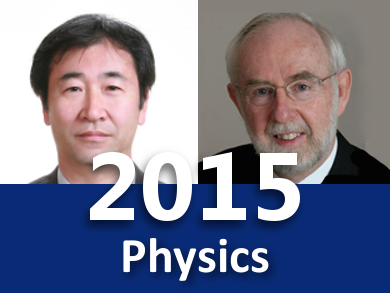The Nobel Prize in Physics for 2015 has been awarded to
- Takaaki Kajita (pictured left), University of Tokyo, Japan, and
- Arthur B. McDonald (pictured right), Queen’s University, Kingston, Canada,
for the “discovery of neutrino oscillations, which shows that neutrinos have mass”.
Neutrinos, first discovered in the 1950s, are neutral particles that exist in huge numbers in the universe, but rarely interact with matter and are thus difficult to detect. There are three types of neutrinos: electron-neutrinos, muon-neutrinos, and tau-neutrinos.
Takaaki Kajita, born 1959 in Higashimatsuyama, Japan, gained his Ph.D. in 1986 from the University of Tokyo, Japan. Since 1988, he has been at the Institute for Cosmic Radiation Research, University of Tokyo, where he was an assistant professor in 1992 and is professor since 1999. Since 1999, Kajita is also Director of the Center for Cosmic Neutrinos at the Institute for Cosmic Ray Research (ICRR).
Takaaki Kajita, using the Super-Kamiokande detector in Japan, captured neutrinos generated by reactions between cosmic radiation and Earth’s atmosphere. The detector consists of an enormous underground tank with 50,000 tons of very pure water and over 11,000 light detectors. The properties of the detected light reveal what type of neutrino it is caused by. The setup detected muon-neutrinos, both those coming from the atmosphere above, and those coming from below through the Earth. Even though equal numbers were expected from both directions, there were fewer neutrinos detected from below. It was postulated that they had more time to change their type from muon- to tau-neutrinos, and were thus not detected.
Arthur B. McDonald, born 1943 in Sydney, Canada, gained his Ph.D. in physics from the California Institute of Technology (Caltech), Pasadena, CA, USA. From 1970–1982, he was research officer at the Chalk River Nuclear Laboratories northwest of Ottawa, Canada, and from 1982–1989 professor of physics at Princeton University, NJ, USA, before he joined Queen’s University, Kingston, Canada. Currently, he is the University Research Chair at Queen’s University.
Arthur B. McDonald studied the neutrinos coming from the sun at the Sudbury Neutrino Observatory (SNO) in Canada, an underground experiment similar to the one described above with 9,500 light detectors in a tank filled with 1,000 tons of heavy water (D2O). When neutrinos originating from the sun are measured on earth, only a third of the expected number is detected. The sun only produces electron-neutrinos, so the transformation to muon-neutrinos and tau-neutrinos was a possible explanation. Counting all three types together, the expected number of neutrinos arrived on Earth.
Together, Kajita’s and McDonald’s experiments gave rise to a revolutionary conclusion: the neutrinos’ transformation, also called neutrino oscillation, requires that the neutrinos have mass. Otherwise they cannot change their type. This contradicts the Standard Model of particle physics, which requires them to be massless.
Publications by Kajita:
- Y. Fukuda et al (Super-Kamiokande collaboration), Evidence for Oscillation of Atmospheric Neutrinos, Phys. Rev. Lett. 1998, 81, 1562. DOI: 10.1103/PhysRevLett.81.1562
Publications by McDonald:
- Q. R. Ahmad et al (SNO collaboration), Measurement of the Rate of νe+d→p+p+e− Interactions Produced by 8B Solar Neutrinos at the Sudbury Neutrino Observatory, Phys. Rev. Lett. 2001, 87, 071301. DOI: 10.1103/PhysRevLett.87.071301
- Q. R. Ahmad et al (SNO collaboration), Direct Evidence for Neutrino Flavor Transformation from Neutral-Current Interactions in the Sudbury Neutrino Observatory, Phys. Rev. Lett. 2002, 89, 011301. DOI: 10.1103/PhysRevLett.89.011301
Also of Interest
- Nobel Prize in Physiology or Medicine 2015,
ChemViews Mag. 2015.
William C. Campbell, USA, Satoshi Ōmura, Japan, and Youyou Tu, China, who transformed the treatment of parasitic diseases, awarded - Nobel Prize in Chemistry 2015,
ChemViews Mag. 2015.
Tomas Lindahl, UK, Paul Modrich, USA, and Aziz Sancar, USA, have been awarded “for mechanistic studies of DNA repair” - The Nobel Prize,
Veronika Belusa,
ChemViews Mag. 2015.
Collection of information on the Nobel Prize




